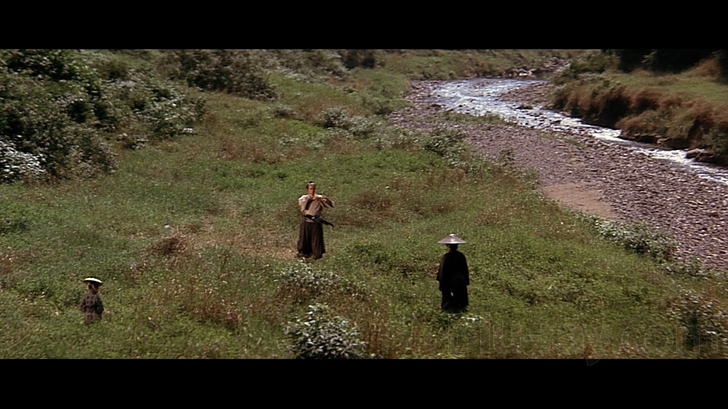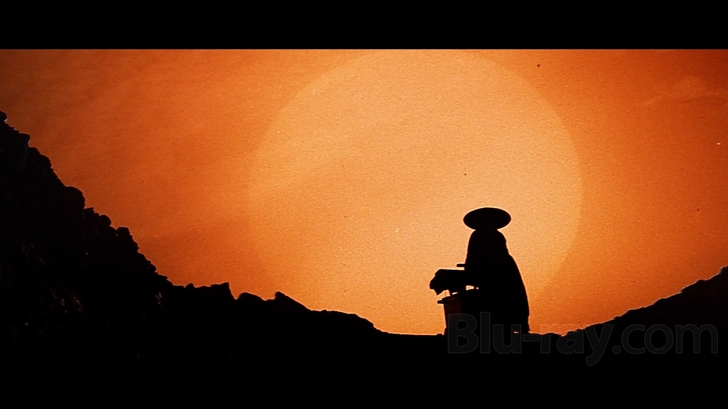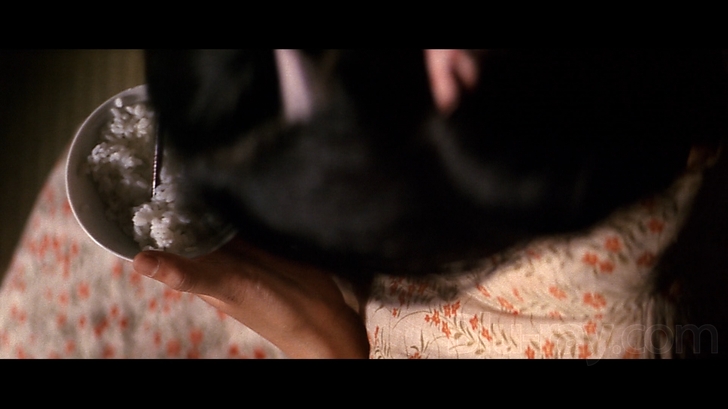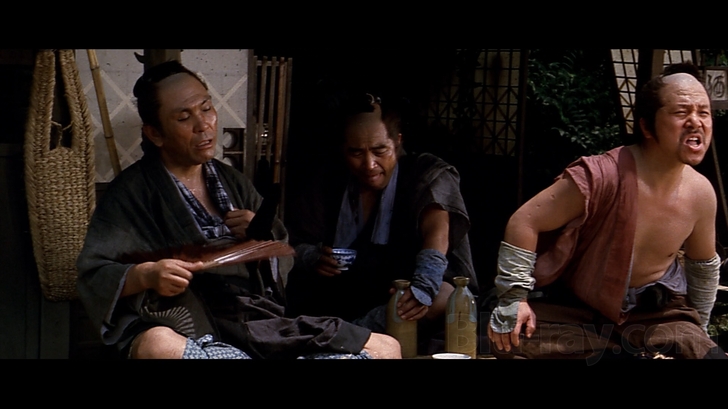Shogun Assassin Box Set Blu-ray Movie
HomeShogun Assassin Box Set Blu-ray Movie 
AnimEigo | 1980 | 5 Movies | 425 min | Rated R | Apr 24, 2012Movie rating
7.7 | / 10 |
Blu-ray rating
| Users | 0.0 | |
| Reviewer | 4.0 | |
| Overall | 4.0 |
Overview
Shogun Assassin Box Set (1980)
In a time of evil and tyranny, a stone-faced ronin wanders the countryside with his young son (and a weapon-filled baby cart), hunted by the merciless minions of an evil Shogun. Once a noble samurai, he is now the most feared assassin in Japan, known only as Lone Wolf.
Starring: Tomisaburo Wakayama, Kayo Matsuo, Minoru Ôki, Akiji Kobayashi, Shin KishidaDirector: Robert Houston (I), Kenji Misumi
| Martial arts | Uncertain |
| Adventure | Uncertain |
| Action | Uncertain |
Specifications
Video
Video codec: MPEG-4 AVC
Video resolution: 1080p
Aspect ratio: 2.35:1
Original aspect ratio: 2.39:1
Audio
English: LPCM Mono
English: Dolby Digital Mono
Subtitles
None
Discs
50GB Blu-ray Disc
Two-disc set (2 BDs)
Playback
Region A (C untested)
Review
Rating summary
| Movie | 3.5 | |
| Video | 4.0 | |
| Audio | 3.0 | |
| Extras | 3.0 | |
| Overall | 4.0 |
Shogun Assassin Box Set Blu-ray Movie Review
Gore-geous.
Reviewed by Jeffrey Kauffman April 14, 2012Everybody have their flowcharts ready? Okay, here we go: in 1970, a popular manga series called Lone Wolf and Cub appeared depicting the feudal Japanese adventures of an official executioner of the Shogun named Ogami Itto who finds himself ostracized after false accusations are leveled against him by a family of feudal lords known as the Yagyu. Itto is consigned to a mercenary like life as a roving assassin, taking along his infant son, Daigoro, with revenge against the Yagyu a primary goal. Two years after the manga appeared, the first of what would become a long running franchise of Japanese film adaptations premiered, starring Tomisaburo Wakayama as Itto. The first film bore the title Lone Wolf and Cub: Sword of Vengeance, and was followed in short order over the ensuing years by Lone Wolf and Cub: Baby Cart at the River Styx, Lone Wolf and Cub: Baby Cart to Hades, Lone Wolf and Cub: Baby Cart in Peril, Lone Wolf and Cub: Baby Cart in the Land of Demons and Lone Wolf and Cub: White Heaven in Hell. In the late seventies, American producer David Weisman obtained rights to the Lone Cub and Wolf film franchise from Toho and with his partner Robert Houston recut the first two films (Lone Wolf and Cub: Sword of Vengeance and Lone Wolf and Cub: Baby Cart in the River Styx), redubbed the edited version into English, and released it to American markets as Shogun Assassin in 1980. The film was deemed to be incredibly violent in its day (an allegation that completely ignores the patently cartoonish aspect of a lot of the violence), and in fact the reaction in overseas markets (especially in Britain) led to savvy marketers using the alluring “banned” appellation once the film started matriculating to home video. Weisman and Houston soon moved on to the third Lone Wolf and Cub film, and then to the succeeding sequels, bringing each of them out dubbed into English as Shogun Assassin 2, Shogun Assassin 3 and so on, though of course Shogun Assassin 2 was in actuality the third film in the Lone Wolf and Cub franchise, since the first Shogun Assassin had been cobbled together from the first two Lone Wolf and Cub outings. See why a flowchart was recommended? Shogun Assassin has always been something of a cult phenomenon, a tendency that was given a new shot in the arm when none other than Quentin Tarantino featured a snippet of the film in Kill Bill Vol. 2.

Shogun Assassin 3.5/5
(For my colleague Casey Broadwater's more in-depth analysis of the standalone release of the first film, read here.)
This first film in the series is in some ways a maddening experience, a combination of both very good elements as well as a sort of nonsensical ambience that is part and parcel of the film having been cobbled together from two sources (though truth be told the bulk of this film actually comes from the second Lone Wolf and Cub outing). Shogun Assassin has been denuded of anything approaching complexity or plot nuance in order to maximize action and not so coincidentally bloodshed. Therefore what initially was an internecine conflict in the Lone Wolf and Cub outings is boiled down to a supposedly easier to understand plotline whereby Itto’s commander, the Shogun himself, ends up becoming paranoid and attempts to kill Itto, managing only to kill Itto’s wife. That sets Itto out on his seemingly endless quest, with his toddler son in tow, living his new life as a mercenary.
Shogun Assassin does an admirable job of setting up the basic plot and characters which will continue to inform the subsequent sequels, as well as moving in an anecdotal fashion from one outlandishly cartoonish battle to the next. Swords bifurcate heads (when they’re not actually chopping them off completely), what look like mere flesh wounds end up unleashing incredible volumes of gushing blood, and martial arts battles seem to erupt from a simple “how do you do” between any two given characters or groups. There’s a great trio of mad female ninjas hot on the trail of Itto (one of them voiced by none other than Sandra Bernhard), and the entire film has a sort of looney-tunes ambience that, while not playing for laughs, is at times strangely reminiscent of that “other” reworked Asian film, Woody Allen’s What’s Up, Tiger Lily?. Director Kenji Misumi has an eye for scenic vistas that helps invest this first outing with an epic sweep, and despite the hyperbolic elements, Shogun Assassin remains a curiously mesmerizing experience.
Shogun Assassin 2: Lightning Swords of Death 2.5/5
The third Lone Wolf and Cub outing is a disturbing piece that may have some of the cartoonish elements of the reedited Shogun Assassin, but which, being the first unedited (though dubbed into English) version of the franchise released as part of the Shogun Assassin series benefits immensely from basically being left alone, preserving its primal elements and making the film seem much more historically relevant (if not particularly accurate) as a result. Daigoro is a little older now, but still is transported around in the perambulator (which is tricked out with a number of feudal versions of spy thriller gizmos), and as Itto and son traverse a river in a ferry, Itto notices he’s being tailed, no doubt by the Yagyu.
Shogun Assassin 2: Lightning Swords of Death has a fair degree of violence toward women dotting its landscape, with two unfortunate women meeting their fates early in the film in a really unsettling rape scene and then, somewhat later, with a longer running arc that features a woman whom Itto initially notices on the ferry and who turns out to be a hapless unfortunate about to be sold into prostitution. Her tangle with her pimp-seller is a visceral sequence in the film, and it places Itto in the unusual position of being a protector rather than a killer.
Despite the pluses of being unedited and being allowed to retain its ostensibly dramatic demeanor, Shogun Assassin 2: Lightning Swords of Death is hampered by an overly anecdotal structure that lurches from segment to segment and which robs the film of much continuity or momentum. The film is often incredibly ludicrous despite its best efforts to take itself seriously, something which becomes completely apparent in the patently ridiculous final showdown, which will have some frustrated viewers screaming to the bad guy, “Just shut up and die already!”.
Shogun Assassin 3: Slashing Blades of Carnage 3.0/5
If the steely faced demeanor of Itto chopping and hacking his way through any number of bad guys hasn’t been enough for you, this third outing offers the additional allure of a leading lady nemesis who is heavily tattooed and isn’t above slaying her foes topless. (It should be mentioned that several of the Shogun Assassin films feature at least passing female nudity). Michie Azuma portrays Oyuki, the female assassin of a feudal warlord, who has gone rogue and is seen in the film’s opening moments dicing and slicing her way through a bunch of supposedly superior males in a forest. The film initially seems to be poised to have a cat and mouse game between Itto, who has been hired to kill Oyuki, and the resourceful woman, but it takes a somewhat surprising left turn after this initial set up is developed.
Daigoro becomes the actual focus of a large swath of Shogun Assassin 3: Slashing Blades of Carnage, when he wanders away from his tricked out baby carriage and ends up getting lost. That puts him in a series of predicaments culminating in a showdown with a nefarious member of the Yagyu family, which in turn leads to a showdown between the Yagyu villain and Itto, who through sheer determination has managed to track down his missing son and is hopefully about to be reunited with him.
Only after this somewhat circuitous route does the film finally return to the supposedly central conflict between Oyuki and Itto. The film then takes another unexpected turn after that battle is actually dispatched rather quickly in a relatively anticlimactic fashion, with a return of two Yagyu clan members who have differing responses to Itto after having done battle with him. There’s the expected gorey finale which actually sees Itto fairly badly wounded. This third installment is a definite step up from the second, with a more cohesive plot (despite its twists and turns), and some outlandish but extremely effective action elements. Itto becomes less of a stony faced cipher in this film, if only because his efforts to find and protect Daigoro finally humanize him, if only a little bit.
Shogun Assassin 4: Five Fistfuls of Gold 3.5/5
This film bears certain similarities to another martial arts film which highly influenced Quentin Tarantino and the Kill Bill films, namely the great Shaw Brothers classic, The Five Deadly Venoms. Like that film, Shogun Assassin 4: Five Fistfuls of Gold posits a quintet of characters who each have individual talents and, in this case, individual knowledge that will help Itto perform what turns out to be his major task in this film. There’s strangely also a somewhat extra-Japanese historical aspect to this film, as it becomes evident that Itto has been enlisted to help calm some turmoil caused by an evil warlord (is there any other kind?), who has locked away his true heir, a son, and placed a daughter he fathered with his concubine in his place, the girl now fitted out to appear male. The locked away heir may remind some of British history, while the girl made to appear male will of course remind some of Disney’s Mulan.
Daigoro once again wanders off in this film and gets mixed up with a female pickpocket, but rather than being a distraction from the main Itto plot, this subplot actually works quite effectively as a mirroring technique, as both father and son are beset by questions of honor, loyalty and duty and how properly to respond in the face of adversity. Dramatically, this is probably the best of the sequels, though it still bears the imprint of ridiculously over the top battle sequences that feature huge splatter elements and near laugh out loud lunacy. Once again women are shown to be no less than formidable opponents, and there’s some interesting suspense in the third act of this film as Itto attempts to divine the true motives of a woman who wants to hire him to kill the scheming warlord.
Shogun Assassin 5: Cold Road to Hell 3.0/5
This might equally have been called Shogun Assassin: Snowbound, for the final act takes place in a frost covered environment that has some odd results, including the iconic baby carriage becoming magically fitted with sled blades instead of wheels. This is in some ways the silliest of the Shogun Assassin films, yet it manages to nonetheless be immensely entertaining most of the time, especially since it seems—until the final moments—to finally be bringing the long simmering conflict between Itto and the Yagyu Clan to a head.
The film also benefits from a supernatural element, as the particular Yagyus in this film practice black magic, lending some of the proceedings a sinister air. This is in some ways the least “traditional” outing for Itto and Daigoro, and in fact it seems largely divorced from the original source material in tone and content. There’s also little doubt that at the time of the film’s production it was probably seen as just another cog in the Lone Wolf and Cub wheel, as the ending is set up for yet another outing with the nefarious Yagyu Clan (which has never occurred—to this date, anyway).
Despite the frozen ambience of the final portion of the film, this is a surprisingly scenic and even epic journey for Itto and Daigoro (who is considerably older and more capable now, making his “home” of the baby carriage seem somewhat anachronistic). If this outing may seem like the filmmakers were stretching a little too hard to invest the series with new life (kind of like the late entries in the Charlie Chan franchise), there’s no denying the film’s basic entertainment value, which while as gory as ever, has a surprising energy for a fifth (or indeed, actually sixth) trip back to the Lone Wolf and Cub well.
Shogun Assassin Box Set Blu-ray Movie, Video Quality 

All five of the Shogun Assassin films are presented on Blu-ray courtesy of AnimEigo with AVC encoded 1080p
transfers in 2.35:1. Fans of these films have been generally very pleased with the previously released AnimEigo DVDs, and
that feeling should continue with these nicely sharp and vividly saturated looking transfers. My colleague Casey
Broadwater previously reviewed the standalone Blu-ray release of Shogun Assassin, and his comments are by and large true for the subsequent films as
well. AnimEigo is to be commended for going the extra mile and sourcing these transfers from the best elements available,
with some beautiful clarity and gorgeous saturation resulting more often than not. As with the first film, the sequels all
show age related wear and tear, and there are quite a few white specks and occasional scratches dotting the landscape,
but overall these transfers are surprisingly clean and well restored. There doesn't appear to have been any overindulgent
noise reduction applied to any of the transfers, and colors pop magnificently (especially that over the top red blood)
throughout all of the films. There is some noticeable, albeit fairly minor, ringing in various shots scattered throughout the films, typically when
foreground objects are backlit. The restoration demo (which was included on the standalone release of the first film) clearly
shows an impressive uptick in fine detail, as well as added clarity and improved color and contrast, something that remains
true for the subsequent films. One passing qualm some may have is the fact that the sequels have all been placed onto
one BD-50, but there were
no egregious compression artifacts resulting, and the overall image quality of the sequels retained the same general sharpness, clarity
and saturation as the first film.
Note: For screencaps of the first film, see Casey's review, linked above. All of the screencaps included with this review come from the
sequels. Screencaps 1-5 are from Shogun Assassin 2, 6-10 from Shogun Assassin 3, 11-15 from Shogun Assassin 4,
and 16-20 from Shogun Assassin 5.
Shogun Assassin Box Set Blu-ray Movie, Audio Quality 

Okay, here's where some of the bad news starts. Only the first film is granted a lossless audio track, an LPCM mono mix pumping out on two channels via an uncompressed 2.0 track. Casey Broadwater's assessment of the first film can be read here. Unfortunately, the rest of the films are granted only lossly Dolby Digital Mono mixes, once again provided via 2.0 tracks. The audio on these sequels suffers at least somewhat from the less than fulsome low end that the lossless track provides to the first film, but otherwise, while audiophiles are no doubt going to be upset (probably with good reason), there's nothing major to complain about here, at least if accepting the Dolby tracks on face value and removing any aspect of "wishing it were different". Fidelity here is just fine, and dynamic range is actually pretty good. Yes, there's not quite the clarity and "oomph" of a lossless track, and that certainly would have been preferable, but what's here is decent, if not fantastic.
Shogun Assassin Box Set Blu-ray Movie, Special Features and Extras 

Shogun Assassin
- Audio Commentary featuring David Weisman (Producer), Jim Evans (Illustrator) and Gibran Evans (Voice of Diagoro). This is an interesting but nicely conversational commentary that is more or less led by Weisman and includes occasional sidebars added by the two Evans (father and son). The elder Evans did the poster art for the film, and when Weisman was auditioning kids right and left to do the voiceover narration in the role of Daigoro, he suggested the Evans have his own kids read for the role, resulting in son Gibran being cast. There are some fun anecdotes here (like the trio meeting THe Governator, Ah-nold himself, when Schwarzzeneger was about to film the Conan movies and wanted to screen Shogun Assassin), as well as some more technical issues like the editing and dubbing processes (Weisman and Houston hired deaf mutes to lip read the Japanese actors so that they could craft English dialogue to match the mouth movements as closely as possible).
- Audio Commentary featuring film scholar Ric Meyers and martial arts expert Steve Watson. This is perhaps a more purely informative commentary, though less personal than the Weisman - Evans commentary. Some history about the Japanese film industry is shared as well as background on the film and actors.
- Samuel L. Jackson Interview (HD; 12:43). This was filmed on Julay 28, 2009 in Los Angeles and has Jackson answering questions that presented as interstitial titles. He talks about how many Asian films are in his collection (a lot!) and why he likes these types of film.
- HD Trailer (HD; 2:35)
- Restoration Gallery (HD; 3:45) features screencaps from a bootleg version, the authorized DVD and the new Blu-ray.
- Program Notes (HD; 10:33) presents text based notes as a slideshow, with each slide lasting 45 seconds, so have your pause button ready. The notes are also available on AnimEigo's website (www.animeigo.com).
- Program Notes function like those on Shogun Assassin.
- Cast and Credits. This is a very handy (and dare I say thoughtful) supplement which provides English translations for all of the Japanese credits throughout the films.
- Trailer (HD; 2:09)
- Trailer (HD; 1:36)
Shogun Assassin Box Set Blu-ray Movie, Overall Score and Recommendation 

The big question that a lot of fans of Lone Wolf and Cub are asking is no doubt: "Just where are the original Japanese language versions of all of these films?" Time will no doubt provide the answer to that trenchant query, and chances are sooner rather than later the originals will be appearing in high definition. But though many consider the Shogun Assassin versions inferior knockoffs, these particular films have their own cultish appeal, and for them, this release is probably going to be very much appreciated. AnimEigo has done themselves proud with some very nice looking transfers, though they have fallen short by only providing lossless audio on the first film. Those who want Lone Wolf and Cub in their original language versions should probably save their hard earned cash for the hoped for day when they're released. For those who want the entire Shogun Assassin series, the benefits of this release probably far outweigh the detriments, and it comes Recommended.
Similar titles
Similar titles you might also like

Lone Wolf and Cub: Baby Cart at the River Styx
子連れ狼 三途の川の乳母車 / Kozure Ôkami: Sanzu no kawa no ubaguruma
1972

Lone Wolf and Cub: White Heaven in Hell
子連れ狼 地獄へ行くぞ!大五郎 / Kozure Ôkami: Jigoku e ikuzo! Daigorô
1974

Lone Wolf and Cub: Sword of Vengeance
子連れ狼 子を貸し腕貸しつかまつる / Kozure Ôkami: Ko wo kashi ude kashi tsukamatsuru
1972

Lone Wolf and Cub: Baby Cart in the Land of Demons
子連れ狼 冥府魔道 / Kozure Ôkami: Meifumadô
1973

Lone Wolf and Cub: Baby Cart in Peril
子連れ狼 親の心子の心 / Kozure Ôkami: Oya no kokoro ko no kokoro
1972

Lone Wolf and Cub: Baby Cart to Hades
子連れ狼 死に風に向う乳母車 / Kozure Ôkami: Shinikazeni mukau ubaguruma
1972

The Tale of Zatoichi
座頭市物語 / Zatôichi monogatari
1962

Zatoichi in Desperation
新座頭市物語・折れた杖 / Shin Zatôichi monogatari: Oreta tsue
1972

Zatoichi the Outlaw
座頭市牢破り / Zatôichi rôyaburi
1967

Zatoichi Goes to the Fire Festival
座頭市あばれ火祭り / Zatôichi abare-himatsuri
1970

Zatoichi Challenged
座頭市血煙り街道 / Zatôichi chikemuri kaidô
1967

Zatoichi at Large
座頭市御用旅 / Zatôichi goyô-tabi
1972

Five Element Ninjas
五遁忍術 / Ren zhe wu di
1982

Last Hurrah for Chivalry
豪俠 / Háo xiá
1979

Dragon Inn
龍門客棧 / Long men kezhan
1967

Legend of the Eight Samurai
里見八犬伝 / Satomi hakken-den | Masters of Cinema | Limited Edition
1983

Shogun's Ninja
Ninja bugeicho momochi sandayu
1980

Zatoichi: Darkness Is His Ally
1989

Blade of the Immortal
無限の住人 / Mugen no jûnin
2017

Six-String Samurai 4K
1998


